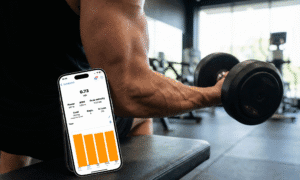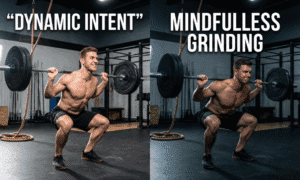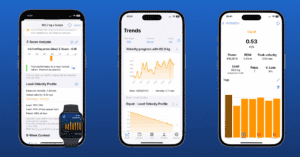In this post, we’ll show you how to get the most reliable results when measuring barbell velocity and jump height with Spleeft. Coach-to-coach, here are the essentials:
- Pause briefly between reps.
- Keep the signal clean—avoid noise immediately before and after each rep.
- Create clear direction changes at the start and end of the concentric phase.
- Avoid slow, overly controlled intent when the goal is velocity.
If you’re seeing “ghost reps” (reps not detected by the algorithm) or you feel your values aren’t as accurate as they should be, this guide will help.
DOWNLOAD SPLEEFT APP NOW FOR PHONE, MAC AND WATCH!
Introduction
You may have read well-known VBT validation papers comparing different devices. Some early studies reported lower reliability for accelerometer-based tools (e.g., certain IMU bands), which led many coaches to assume that any accelerometer-driven solution was imprecise. More recent work on newer IMU devices has shown substantially improved outcomes. You can also read our latest validation study for Spleeft.
Ultimately, when using an iPhone or Apple Watch as Spleeft does, accuracy hinges on the algorithm processing the accelerometer signal. As we explained in our post on the data science project behind Spleeft, accelerometers are very sensitive and inherently noisy because they register all forces acting on the device—unlike linear encoders, which only track cable movement along a single axis.
There is also a mathematical constraint: integrating acceleration to obtain velocity introduces a constant bias that must be corrected. After years of testing, we’ve found that a robust zero-recalibration approach is the most effective way to suppress noise and compensate for drift, yielding our most reliable results. The trade-off is a small learning curve for the lifter.
Pause Briefly Between Reps
Spleeft needs short motionless windows (“zeros”) to recalibrate the signal. In many movements (e.g., squats or machine work), this pause is well under a second. In bench press, because you’re stabilizing the bar with your arms, the pause may need to be a touch longer. For deadlift, we recommend resting the bar on the floor between reps to ensure a clean zero.
In practice, wait for the green indicator before you initiate the next rep—that confirms recalibration. In Boost mode, your Apple Watch will vibrate when a zero is detected; on iPhone, you’ll hear the “Go!” cue. n Balanced mode, you’ll only hear the velocity once recalibration has occurred.
This applies to the first rep, too. After the countdown, you might still be moving to get set. If you don’t wait for the green indicator again, that first rep might not be counted (the app assumes velocity is zero when the set begins). On machines like the leg press, frame damping often reduces vibrations, making zeros easier to detect.
Bottom line: take that brief pause between reps. If you’re concerned about “losing” training effect, consider using cluster sets—short intra-set pauses can actually enhance quality and power.
In this video you can see the perfect situation for our algorithms to work with a high accuracy. Wait until the countdown finishes. Start each movement with the zero indicator in green. Wait a bit between reps until the noise disappears and the signal recalibrates. We have chosen a noise exercise, in others like squats the response time will be lower.
Keep Your Signal Clean
Start each rep as soon as the signal is green, and finish by getting still as quickly as possible. The shorter the analysis window, the less noise and drift the algorithm must handle.
Most “missed rep” feedback comes from bench press and deadlift. In the default Boost mode, it’s rare to miss reps—unless the signal is noisy right from the start. Aim for “green to green”: only initiate when you see the green indicator (you’re motionless) and try to return to a green screen quickly after lockout.
Create Clear Direction Changes
Once the signal is clean, the next priority is accurately bracketing the concentric phase: from a zero/hold, through positive (upward) acceleration, to another zero/hold. A distinct change of direction helps the algorithm mark the start and end of this phase with high confidence.
This is especially evident in the back squat, one of our most reliable movements. You reverse from the eccentric to the concentric at the bottom, and at the top many lifters finish with a subtle calf-driven “pop,” then settle back onto full foot contact—a tiny negative-to-zero shift—before the brief pause for recalibration.
For deadlifts, it’s less obvious. The end-of-rep is where minor noise can accumulate, so be deliberate with the direction change at the top, and then let the bar return to the floor to force a clean zero before the next rep.
Avoid Overly Controlled Reps
Spleeft’s reliability depends on identifying true motionless periods to recalibrate. In simplified terms, the algorithm looks for time windows where acceleration is near zero. In physics, zero acceleration doesn’t always mean zero velocity—it can also mean constant velocity. Long stretches of “too smooth” motion can trick the system into thinking you’ve paused when you haven’t. You’ll see this in three common scenarios:
- Low intent reps. High-intent concentric action not only drives better strength and power adaptations; it also improves detection. Move the bar with intent when training velocity.
- Very slow grind reps. Near-1RM efforts can include sticking points with minimal acceleration. Spleeft includes automatic filters, but you can fine-tune manually. Example: if your bench press is ~0.30 m/s with ~0.25 m ROM, set rep filters near those values to instruct the algorithm: “If the trace looks slower/shorter than this, cut and re-process later in the rep.”
- Slow eccentric/braking. Intentionally slow eccentrics (e.g., deadlift negatives for time-under-tension, or machine work to avoid plate clash) can produce long low-acceleration segments while the device is still moving. Keep eccentrics purposeful, but if you’re training velocity, avoid excessively slow descents.
As a mental model, picture a technically sound back squat as the Spleeft “ideal”: high intent, clear direction change at the bottom and at lockout, and the bar resting on your back at the top—damping noise and helping zeros arrive sooner. Try to make your other exercises behave more like this, within the constraints of each lift.
We hope these tips help you get the most from Spleeft. While it isn’t a laboratory-grade instrument for velocity or jump height, following these best practices will give you dependable, coachable data and a smooth entry into velocity-based training.
Iván de Lucas Rogero
MSC Physical Performance & CEO SpleeftApp
Dedicated to improving athletic performance and cycling training, combining science and technology to drive results.





